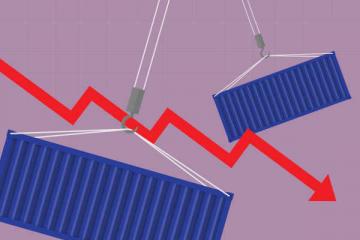Manufacturing output began 2024 where 2023 left off, with a modest uptick while remaining below its benchmark reading for growth, according to the new edition of the Manufacturing Report on Business, which was issued this week by the Institute for Supply Management (ISM).
The report’s benchmark metric, the PMI, came in at 49.1(a reading of 50 or higher indicates growth), up 2.0% over January’s 47.1 reading, contracting, at a slower rate, for the 15th consecutive month. The past 15 months of contraction were preceded by a stretch of 28 consecutive months of growth. ISM also said that the overall economy grew in January, at a faster rate, for the 45th consecutive month.
The January PMI is 1.9% above the 12-month average of 47.2, with January 2024 marking the high for that period, at 49.1, and June 2023, at 46.4, marking the lowest.
ISM reported that four manufacturing sectors reported growth in January, including: Apparel, Leather & Allied Products; Textile Mills; Transportation Equipment; and Chemical Products. Sectors that saw contraction included: Wood Products; Machinery; Plastics & Rubber Products; Nonmetallic Mineral Products; Furniture & Related Products; Computer & Electronic Products; Fabricated Metal Products; Petroleum & Coal Products; Food, Beverage & Tobacco Products; Electrical Equipment, Appliances & Components; Paper Products; Miscellaneous Manufacturing; and Primary Metals.
The report’s key metrics were mostly up in January, including:
- New Orders, which are considered the engine that drives manufacturing, rising 5.5%, to 52.5, growing for the second time in the last 20 months, with five sectors reporting growth;
- Production was up 0.5%, to 50.4, growing for the fourth time in the last 14 months, with four sectors reporting growth;
- Employment, at 47.1, was down 0.4%, contracting, at a faster rate, for the fourth consecutive month, with three sectors reporting growth;
- Supplier Deliveries, at 49.1 (a reading above 50 indicates contraction), grew faster, at a faster rate, for the 16th consecutive month, with five sectors reporting slower deliveries;
- Backlog of Orders, at 44.7, decreased 0.6, contracting, at a faster rate, for the 16th consecutive month (which was preceded by a 27-month stretch of growth), with two sectors reporting growth;
- Prices, at 52.9, rose 7.7%, increasing after eight months of declines, with 10 sectors reporting paying higher prices;
- Inventories, at 46.2, were up 2.3%, contracting, at a slower rate, for the 12th consecutive month, with three sectors reporting higher inventories; and
- Customer Inventories, at 43.7, were down 2.7%, moving “too low” after being “too high” in November, with six sectors reporting customers’ inventories as too high
Comments submitted by the ISM member panelists again highlighted various themes related to the economy and market conditions.
“The start of 2024 looks good, said a Chemical Products panelist. “Sales are above expectations, and costs are mostly stable. A few commodities are up in cost due to supply shortages. Many previously short commodities market positions have corrected themselves. There is a real short-term increase in the cost of international freight.”
An Electrical Equipment, Appliances & Components panelist said that demand continues to be slow, observing that reduction from the second half of 2023 has continued into this year, with his company adjusting production to match demand.
Tim Fiore, Chair of the ISM’s Manufacturing Business Survey Committee, said in an interview that he was pleasantly surprised at the PMI reading in the 48.4-to-48.5 range.
“On the input side (supplier deliveries, inventories, prices, and imports), suppliers getting close to 50 is really good,” he said. “It says that either they’ve downsized appropriately, and now they have limited capacity, which is causing strains on their output. Or their customers have issued a lot more orders to them, which is causing them to kind of bind up a little bit, or some combination of both of those, and it’s probably the combination of both of those. Suppliers will generally release people a lot faster than their customers will, because they won’t even think about holding on to people that they can’t afford to.
With inventories still relatively low to close 2023 and start 2024, Fiore said 2023 closed with strong cash flow generation, coupled with Federal Reserve Chair Jay Powell previously stating that the interest rate is going to drop sometime this this year, represents what he called a “huge benefit” for manufacturing, as it indicates it will not be further negatively impacted out into the future, when the opportunity accelerates in and have the right capacity in the right place at that time.
He said the 2.3% increase in inventories is a positive, adding that by March he expects it to be in the 49.5-to-51 range.
“I think the balance of companies are willing to invest in working capital because at this point, they were very lean and very thin,” he said. “They’re bringing in extra stuff they can convert it into shipments. I think the input side is really good.”
As for outputs (the production and employment indexes), Fiore said they were in line with December, which is good, as it represents stable billings, revenue, and cash flow, which is essentially flat with no growth and no real decline.
Manufacturing employment continues to be reduced, he noted, with manufacturing at a 1-to-1.35 hire-to-fire ratio, which is at its highest level since he began tracking this data in 2020.
“There’s more [companies] eliminating people than there are hiring people, and that is the first time I’ve seen that, since I’ve been tracking that metric and I think that’s good,” he said. “We still trying to right-size the labor force…consistent with the first six months of demand at the panelists’ companies. I don’t think they’re sizing themselves from the second six months. I think they’re sizing themselves for the first six months.
In looking at the January data on balance, Fiore said that things are trending somewhat positively a month earlier than he expected, adding he thinks the PMI could hit the 50 mark by March.
“I feel more confident about that,” he said. “I thought January would be around 48 and some change, followed by 49 and some change in February. We are at 49.1, so I now would expect February to be 49.3 and then by the time we get to the end of March, we are going to be at 51.”
The biggest risk for manufacturing, going forward, is what Fiore called the return of “unacceptable inflation,” as demand comes back and inventory levels at higher-than-preferred levels as a result of a soft landing or a touch and go economy.
SC
MR


More Supply Chain Management
- MIT CTL offering humanitarian logistics course
- Bridging the ESG gap in supply chain management: From ambition to action
- Few executives believe their supply chains can respond quickly to disruptions
- Technology’s role in mending supply chain fragility after recent disruptions
- Survey reveals strategies for addressing supply chain, logistics labor shortages
- How CPG brands can deliver on supplier diversity promises
- More Supply Chain Management
Latest Podcast

 Explore
Explore
Business Management News
- MIT CTL offering humanitarian logistics course
- Bridging the ESG gap in supply chain management: From ambition to action
- Few executives believe their supply chains can respond quickly to disruptions
- Technology’s role in mending supply chain fragility after recent disruptions
- Survey reveals strategies for addressing supply chain, logistics labor shortages
- How CPG brands can deliver on supplier diversity promises
- More Business Management
Latest Business Management Resources

Subscribe

Supply Chain Management Review delivers the best industry content.

Editors’ Picks




